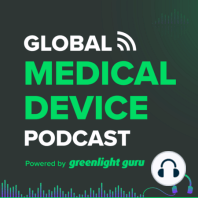29 min listen

Building Your Bill of Materials (BOM) to Accommodate Crossfunctional Needs
FromGlobal Medical Device Podcast powered by Greenlight Guru
Building Your Bill of Materials (BOM) to Accommodate Crossfunctional Needs
FromGlobal Medical Device Podcast powered by Greenlight Guru
ratings:
Length:
28 minutes
Released:
Mar 23, 2022
Format:
Podcast episode
Description
For many new medical device professionals a bill of materials (BOM) may feel like a big black box. Who owns it? How does it function within a QMS? How is it used differently in design versus in manufacturing?In this episode of the Global Medical Device Podcast, Jon Speer and Etienne Nichols learn the answers to these common questions, and more, about a medical device bill of materials from guest Mark Rutkiewicz, VP of Quality at Innovize, Founder of Consiliso LLC, and author of Medical Device Company In A Box.Mark has more than 30 years of experience in the medical device industry and takes organizations to the next level of quality system, product development, and operational excellence. His vision, experience, and hands-on leadership drive best practices in quality system processes and project management.Some of the highlights of this episode include:The FDA and ISO quality system requirements include design controls, which have a direct correlation to BOMs.The Design History File (DHF), Device Master Record (DMR), and Device History Record (DHR) are parts associated with design controls. Mark explains the difference between the three to build a product.For BOMs, there needs to be one source of the truth and everything else needs to match it. A master document needs to be defined, then other files and records copy and configure the same data.Based on configuration management, BOMs should include several components, such as a unique identifier/part number, description of part, quantity, unit of measure, operations step, assemblies, and reference designators.When building a BOM, define attributes or metadata that accommodate manufacturing and design points of view to avoid confusion.Design a flexible system. If you design for flexibility, then you’ll never have to worry about changing your quality system because it can’t handle a new product.Determine the rules of interchangeability. As products change, remember to change the part number and update the version on the BOM.Who owns the BOM? The medical device manufacturer owns the BOM because they are the approver and own the DMR and DHF.Memorable quotes from Mark Rutkiewicz:“The Bill of Materials, you can also grow it to be a Bill of Documents and a Bill of Operations. All that is sort of what’s required to build a product.”“That’s why there’s multiple documents today. The manufacturing people want to see it this way. The design people want to see it this way. They’re not talking to each other.” “If you design for flexibility, then you’re never going to have to worry about, ‘Oh, I ve got to change my quality system because I got this new product because my quality system can’t handle it.’” “Every digit in the part number means something.” Links:FDA - Quality System (QS) RegulationISO - Quality Management Systems RequirementMark Rutkiewicz on LinkedInMark Rutkiewicz on TwitterInnovizeConsiliso LLCMedical Device Company In A Box: The Case For ConsilisoBill of Materials (BOMs)Design History File (DHF) vs. Device Master Record (DMR) vs. Device History Record (DHR): What’s the difference?Greenlight Guru AcademyThe Greenlight Guru True Quality Virtual SummitMedTech True Quality Stories PodcastGreenlight Guru YouTube ChannelGreenlight Guru
Released:
Mar 23, 2022
Format:
Podcast episode
Titles in the series (100)
An Insider’s Look at the Changes Coming in ISO 13485:2016 with Mark Swanson: Did you know ISO 13485 has been revised and approved in 2016? And is going to be published later this month. The quality management standard we’ve all grown to know is now being updated, and we’ll explain more on this episode of the Global Medical De... by Global Medical Device Podcast powered by Greenlight Guru